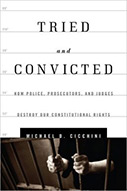Tried and Convicted: How Police, Prosecutors, and Judges Destroy Our Constitutional Rights

Author: Michael D. Cicchini
Publisher: Lanham, MD: Rowman & Littlefield Publishers, 2012. 176p.
Reviewer: Jack E. Call | November 2013
Michael Cicchini is a defense attorney whose experiences in the criminal justice system, judging from this book, have not been particularly positive. His intended audience is the general reader. His purpose is to demonstrate that our criminal law is far more expansive than it needs to be and that the criminal justice system regularly diminishes the constitutional rights of citizens.
The basic premise of Tried and Convicted is that our criminal justice system suffers from too many “soft laws.” Too many criminal laws and too many constitutional rights (as interpreted by courts) give prosecutors and judges too much freedom to overcharge and deprive defendants of their rights. Cicchini urges the reader to take this criticism seriously because “anyone can get charged with a crime for virtually anything” (p. 22).
With regard to interrogations, for example, the “soft” rules established by Miranda v. Arizona have resulted in the exclusion of so little evidence obtained in violation of Miranda that there is little reason for the police to stop questioning if a suspect invokes his or her rights. They are no worse off than if they stop the questioning. In addition, the police can easily coerce a suspect into waiving their rights. This may make his statement inadmissible, but often the police may still be able to use evidence obtained as a result of the statement. The rule that the police need not honor a suspect’s ambiguous request for an attorney receives special criticism, because courts have taken such a narrow view of what constitutes an unequivocal request for an attorney.
Cicchini characterizes the Fourth Amendment warrant requirement as “a suggestion rather than a requirement” (p. 43). Consent searches are the biggest problem because the police “can outright lie and say that you gave consent by your words or even by your actions…. Or more commonly, the officer can simply coerce you into consenting” (pp. 43-44). Cicchini also implies that the exclusionary rule has been all but eliminated by the Supreme Court.
The author expresses special concern about judicial restrictions on the right to confrontation by the witnesses against a defendant. Courts so frequently permit the introduction of hearsay by the prosecution that the right of defense counsel to point out weaknesses in the evidence through cross-examination has been seriously undermined. Even when the Supreme Court acknowledged this problem in a 2004 decision, its new approach created a new, significant loophole. Hearsay evidence is still admissible if the primary purpose of the hearsay statement was to help the police resolve an ongoing emergency (or to obtain medical assistance). The result is that “police, with the help of prosecutors, will actually design and structure their investigations well ahead of time in order to later defeat the right of confrontation in court” (p. 62).
These are just the beginning of Cicchini’s lengthy list of problems with the criminal process. The right to a speedy trial is virtually nonexistent, because the Supreme Court’s totality of the circumstances test for denial of the right is putty in the hands of judges who accept virtually any justification by the prosecution for delay. The right to a jury trial has been seriously undermined because judges typically refuse to permit defense attorneys to ask the kinds of questions that are necessary to identify prejudiced jurors. In addition, the right against the use of peremptory challenges by the prosecutor to remove jurors of a particular race is also illusory because judges typically accept any racially neutral explanation for the use of such challenges that are offered by the prosecution.
Appellate courts are lax in reviewing claims of bias on the part of judges. Cicchini is especially critical of the courts’ handling of cases involving judges who accepted bribes. There is a very good chance that defendants who did not offer bribes will be disadvantaged when they appear before these judges, because such judges are likely to take a very hard line against these defendants so the judges can avoid the appearance of being too generous to them. Nevertheless, the appellate courts have required defendants to prove specific acts by these judges that resulted in actual harm to the defendant.
The system is also allegedly deficient in controlling prosecutor misconduct. Rather than judges being proactive in preventing such misconduct, they require defense attorneys to raise objections to prosecutor misbehavior. This runs the risk of making defense attorneys appear obstructionist in the eyes of jurors. In addition, if the defense succeeds in proving prosecutor misconduct, the typical remedy is declaration of a mistrial with the opportunity to re-try the defendant; a remedy that does little to discourage prosecutors from engaging in misconduct.
The law, says the author, also fails to sufficiently protect defendants when they enter into plea agreements. Prosecutors should be required to honor their agreements, rather than simply affording defendants the opportunity to withdraw their plea if a prosecutor reneges on a deal (or the deal of a fellow prosecutor). When judges sentence defendants, he notes, they should not be permitted to impose a “jury tax” by awarding a higher sentence on defendants who plead not guilty. Nor should judges be permitted to consider dropped charges in awarding sentence.
When defense attorneys fail to provide adequate representation, the rules for proving ineffective assistance of counsel are, Cicchini believes, unfair. First, the defense must overcome a strong presumption that the trial lawyer behaved competently. Second, even if that hurdle is overcome, the defense also must prove that it was this incompetence that was responsible for the conviction and not the strength of the prosecution’s evidence.
The primary strength of this book is the quality of the writing. Cicchini’s intended audience, the general public, should have no difficulty understanding his arguments or maintaining interest in the book. The author’s writing is clear, lucid, and accessible. In spite of the broad range of topics discussed, the book is surprisingly short. Even lower level undergraduate students should have no difficulty understanding and remaining engaged with the book.
The shortcomings of the book are, however, significant. First, while the succinctness of the discussion of each topic is part of what makes the book so accessible to the average reader, this comes with a price. Many of the topics would have benefited from more thorough analysis. For example, while being highly critical of the courts for being too generous in permitting the hearsay testimony of unavailable witnesses, Cicchini does not mention that on occasion the reason a witness has become unavailable is that the witness is unwilling to testify because of threats, either from the defendant or from friends of the defendant or, more rarely, because the witness has been killed. In addition, often the hearsay testimony at trial consists of sworn testimony given by the witness prior to trial in a setting where the defense had an opportunity to cross examine the witness, such as at a preliminary hearing. Neither of these points makes Cicchini’s arguments invalid, but they do place the arguments in a broader perspective.
Another example concerns his treatment of the right to a speedy trial. While he points out that the remedy for a violation of the constitutional right to a speedy trial (as opposed to a statutory right) is dismissal of the charges with prejudice, he does not point out that in many cases that remedy is arguably disproportionate to the harm caused the defendant. Perhaps more proportionate remedies would make judges less reluctant to rule in favor of defendants in speedy trial cases. In addition, Cicchini does not mention that defendants often benefit from lengthy delays because prosecution witnesses sometimes die or become unavailable or their memories become less clear.
A second shortcoming of this book is the propensity for engaging in overstatement. For example, in discussing the role of judges in making findings of fact in suppression hearings, Cicchini indicates that judges "will simply accept as true whatever version of events the police tell them” (p. 71). He indicates that the police frequently lie at suppression hearings. If they forget to say what the prosecutor wanted them to say, the author accuses judges of being there to “bail the prosecutor out and find a way to admit the evidence” (p. 73).
Another example is Cicchini’s discussion of the lax approach that the law and judges take to prosecutor misconduct. One of the reasons that defense claims of prosecutor misconduct seldom succeed is that on appeal, “the appellate court has only one goal: to preserve, rather than overturn, [a] conviction” (p. 118). This is not to say that he has no valid points to make, but his frequent use of the word “will” (“judges will,” “the police will,” or “appellate courts will”) undermines the reader’s confidence in his objectivity. Many readers are likely to be left with the impression that police, prosecutors, and judges are engaged in an implicit conspiracy to do all that is humanly possible – including committing perjury – to ensure that defendants are prohibited from enjoying the benefits of their constitutional rights. There can be no doubt that this occurs all too often in our criminal justice system, but its true frequency is far from clear from the empirical literature. And this book does not make that clear.
REFERENCES
Miranda v. Arizona, 384 U.S. 436 (1966).
Jack E. Call, Professor of Criminal Justice, Radford University


